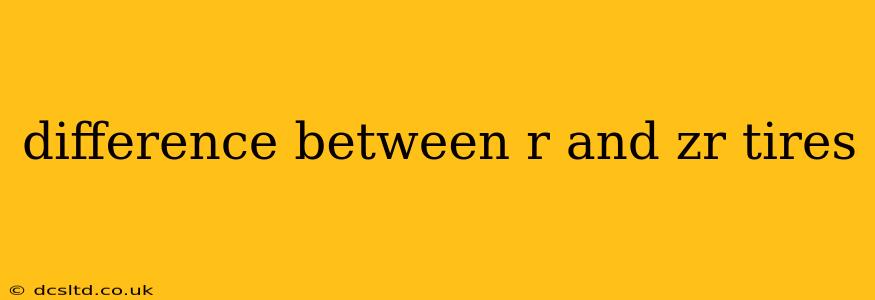Choosing the right tires for your vehicle is crucial for safety, performance, and longevity. Two common designations you'll encounter are "R" and "ZR," often causing confusion. This article clarifies the key differences between R and ZR tires, helping you make an informed decision for your next tire purchase.
The core difference lies in speed rating. This rating indicates the maximum speed a tire can safely sustain. While both R and ZR tires are designed for high-performance, ZR tires are built for significantly higher speeds.
What does the "R" in R-rated tires mean?
The "R" in R-rated tires stands for radial. This refers to the tire's construction, where the plies of fabric run radially from the bead to the center of the tire. Almost all modern passenger car tires are radial tires, making the "R" designation less about a specific performance category and more about the construction method. R-rated tires typically have speed ratings ranging from S (112 mph) to W (168 mph).
What does "ZR" mean in ZR-rated tires?
ZR-rated tires are also radial, but the "ZR" signifies an extended speed rating. ZR tires are designed to handle speeds exceeding 149 mph (240 km/h). This higher speed capability often correlates with enhanced performance characteristics like better handling and grip at high speeds. Note that the exact speed rating for a ZR tire is still indicated by a letter code following the ZR designation (e.g., ZR240).
What are the key differences between R and ZR tires?
| Feature | R-Rated Tires | ZR-Rated Tires |
|---|---|---|
| Speed Rating | Up to 168 mph (W rating) | Exceeds 149 mph (ZR rating + letter code) |
| Construction | Radial | Radial |
| Performance | Suitable for most driving conditions | Optimized for high-speed performance and handling |
| Cost | Generally less expensive | Generally more expensive |
| Typical Use | Everyday driving, high-performance cars | High-performance sports cars, supercars |
How do I know which tire is right for my vehicle?
The best tire for your vehicle is determined by several factors, not just the speed rating. Consult your vehicle's owner's manual for the recommended tire size, load index, and speed rating. Ignoring these recommendations could compromise safety and void your warranty.
Are ZR tires necessary for everyday driving?
No, ZR tires are generally not necessary for everyday driving. Unless you regularly drive at very high speeds, the increased cost and potentially less comfortable ride of ZR tires may not be justified. R-rated tires offer excellent performance and safety for most drivers.
What are the advantages of ZR-rated tires?
- Higher speed capability: ZR tires are designed to safely handle speeds significantly exceeding those of R-rated tires.
- Enhanced handling: They often feature advanced tread compounds and construction for improved handling and grip, especially at high speeds.
- Improved responsiveness: ZR tires can provide more precise steering response and better cornering capabilities.
What are the disadvantages of ZR-rated tires?
- Higher cost: ZR tires are generally more expensive than R-rated tires.
- Potentially harsher ride: The stiffer sidewalls often found in ZR tires can lead to a less comfortable ride on rough surfaces.
- Reduced tire life (sometimes): The performance-oriented compounds used in some ZR tires may wear out faster than those in R-rated tires.
Ultimately, the choice between R and ZR tires depends on your specific needs and driving style. Prioritize safety and consult your vehicle's owner's manual and a tire professional to make the best decision for your car. Remember to always check the complete tire specification, not just the speed rating, as this will provide a comprehensive picture of the tire's capabilities.
